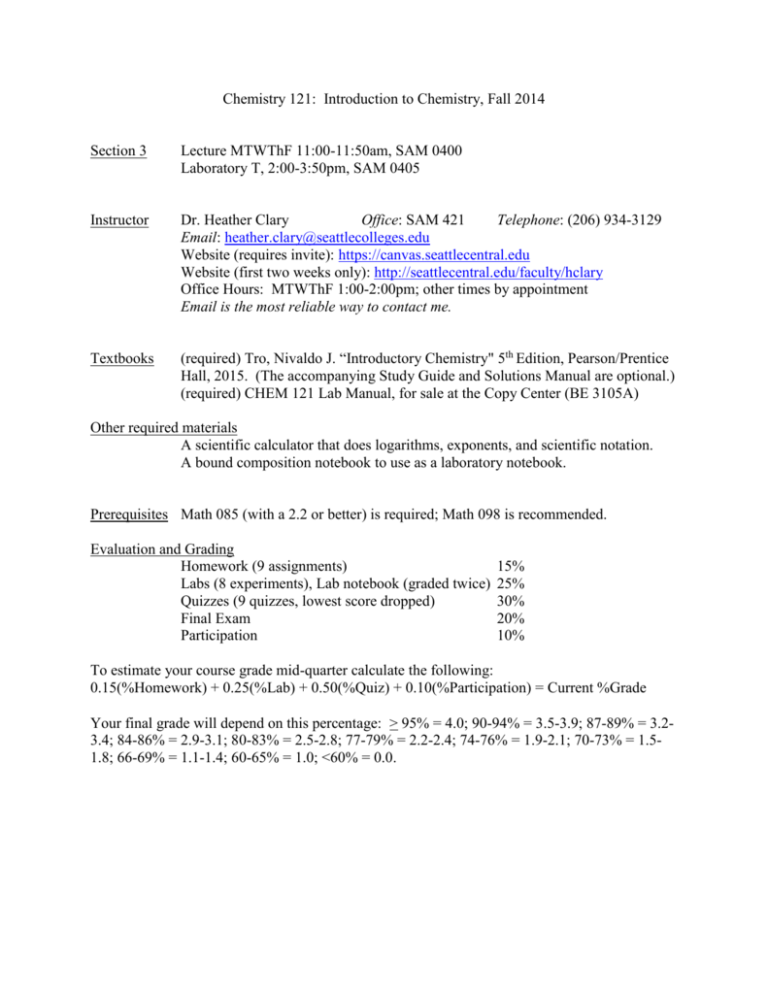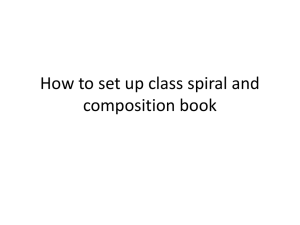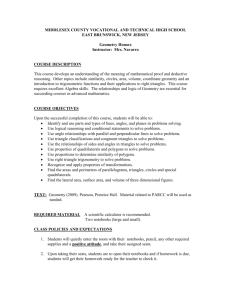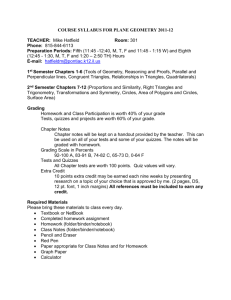
Chemistry 121: Introduction to Chemistry, Fall 2014
Section 3
Lecture MTWThF 11:00-11:50am, SAM 0400
Laboratory T, 2:00-3:50pm, SAM 0405
Instructor
Dr. Heather Clary
Office: SAM 421
Telephone: (206) 934-3129
Email: heather.clary@seattlecolleges.edu
Website (requires invite): https://canvas.seattlecentral.edu
Website (first two weeks only): http://seattlecentral.edu/faculty/hclary
Office Hours: MTWThF 1:00-2:00pm; other times by appointment
Email is the most reliable way to contact me.
Textbooks
(required) Tro, Nivaldo J. “Introductory Chemistry" 5th Edition, Pearson/Prentice
Hall, 2015. (The accompanying Study Guide and Solutions Manual are optional.)
(required) CHEM 121 Lab Manual, for sale at the Copy Center (BE 3105A)
Other required materials
A scientific calculator that does logarithms, exponents, and scientific notation.
A bound composition notebook to use as a laboratory notebook.
Prerequisites Math 085 (with a 2.2 or better) is required; Math 098 is recommended.
Evaluation and Grading
Homework (9 assignments)
Labs (8 experiments), Lab notebook (graded twice)
Quizzes (9 quizzes, lowest score dropped)
Final Exam
Participation
15%
25%
30%
20%
10%
To estimate your course grade mid-quarter calculate the following:
0.15(%Homework) + 0.25(%Lab) + 0.50(%Quiz) + 0.10(%Participation) = Current %Grade
Your final grade will depend on this percentage: > 95% = 4.0; 90-94% = 3.5-3.9; 87-89% = 3.23.4; 84-86% = 2.9-3.1; 80-83% = 2.5-2.8; 77-79% = 2.2-2.4; 74-76% = 1.9-2.1; 70-73% = 1.51.8; 66-69% = 1.1-1.4; 60-65% = 1.0; <60% = 0.0.
Homework
Working through problems is the best way to understand chemistry. There will be one
homework assignment due per week, generally at the end of class on Thursday. Assigned
problems will be from the text, check website regularly for updated problem lists. Note that
answers to selected problems are in the back of the book. For full credit, show all work needed
to derive the answers, and offer explanations as necessary. Selected problems may be checked
for correctness, however most of the points will be awarded based on completeness and
timeliness. Answer keys will be available online after the homework is collected; it is your
responsibility to check your answers against the key. Ask questions when your answers differ!
The more problems you do, the more likely you are to succeed in this course; working additional
problems beyond those assigned is highly recommended.
Labs
Come to lab prepared! Read the experiment, prepare the lab notebook, and complete the pre-lab
assignment in advance of your lab period. Pre-lab assignments are due at the beginning of the
lab period, lab notebooks will be initialed by the instructor shortly after experimentation begins.
Record data and observations in your lab notebook as you proceed with the experiment, copying
final numbers and other requested information into the report sheets (available in the lab manual)
once you are done. Report sheets must be initialed by the instructor prior to leaving the lab to
receive full credit. Lab reports, the combination of the report sheet along with answers to the
post-lab questions, will be due at the beginning of the next lab period. No make-up labs will be
allowed. The last day to check out of lab is December 10. Penalty if not checked out by then is
25% off the final exam.
Quizzes
Nine 25-30 minute quizzes will be given over the course of the quarter; one quiz each Friday.
Your lowest quiz score will be dropped. Bring your calculator; no other materials or notes will
be permitted. A copy of the periodic table will be provided as needed. Any student caught
cheating will receive no credit for that quiz. If you can’t make a quiz as scheduled, you must
contact me before the quiz takes place if you would like to arrange a make-up. Make-ups will
only be considered if documented reasons for the absence are presented, otherwise this will be
the quiz you drop.
Final Exam
The final exam is cumulative, covering concepts from the entire quarter. In order to pass this
course, you must take the final exam. The final exam will take place on Monday, December 8,
10:30am.
Participation
Your participation score is based on attendance and effort displayed during the class.
Participation in group exercises is expected. About once a week worksheets (available in class
and online) will be distributed; these are to be worked on in groups of two or more students, and
one completed worksheet per group (don’t forget anyone’s name!) will be turned in for
participation credit after we discuss the problems in class.
CHEM& 121 Course-Level Student Learning Outcomes
Student Learning Outcomes:
After successful completion of this course, students will be able to do the following:
1. GENERAL SCIENCE, LABORATORY SCIENCE, AND MICROSCALE
Apply the scientific method and use empirical data and observations to construct a sound
scientific explanation.
Distinguish between macroscopic observables and the underlying microscopic properties
of matter by interpreting and representing matter using molecular-level drawings.
Demonstrate effective laboratory practices in conducting experiments and reporting
experimental results (including the proper application of significant figures, precision,
and accuracy).
2. CHEMICAL PROBLEM SOLVING
Demonstrate strong problem-solving skills that are supported by basic algebraic and
numeracy skills.
Demonstrate fluency in chemical vocabulary and symbolic representation.
Use measurable quantities of matter to determine physical and chemical properties.
Use stoichiometric calculations to predict quantities.
3. ATOMS, MOLECULES AND IONS
Describe the general structure of an atom.
Explain the historical development of the atomic theory and the evolution of the current
modern atomic model.
Explain the relationship between the position of an element in the periodic table and its
physical and chemical properties, including periodic trends.
Describe the differences in the structure and properties of substances based on different
types and models of bonding.
4. STATES OF MATTER: GASES, LIQUIDS AND SOLIDS
Compare and contrast the properties of the three states of matter.
Use kinetic-molecular theory to explain ideal gas behavior.
Describe intermolecular forces and chemical bonds and how they influence physical
and chemical properties and changes.
5. PHYSICAL CHANGES AND CHEMICAL REACTIONS
Recognize and describe changes in heat and temperature associated with physical and
chemical changes.
Classify and balance chemical equations and predict products for different types of
reactions.
Apply the properties of ionic and molecular substances in aqueous solution to describe
systems and predict behavior.
Recognize what factors influence reaction rates.
Distinguish between chemical and nuclear reactions.
Tentative Course Schedule (changes will be announced in class)
Week
1
Dates
Sept. 22-26
2
Sept. 29-Oct. 3
3
Oct. 6-10
4
Oct. 13-17
5
Oct. 20-24
6
Oct 27- 31
7
Nov. 3-7
8
Nov. 10-14
(no class Tues)
9
Nov. 17-21
10
11
Nov 24-26
(no class ThF)
Dec. 1-5
12
Dec. 8
Chapters covered and Lab:
Reading: Chapter 1 (The Chemical World) and Chapter 2 (Measurement
and Problem Solving)
Lab: Introduction and Lab Safety
Reading: Chapter 3 (Matter and Energy) and Chapter 4 (Atoms and
Elements)
Lab: Check-in; Experiment 1—Introduction to the Metric System
Reading: Chapter 4 continued and Chapter 5 (Molecules and
Compounds)
Lab: Experiment 2—Density
Reading: Chapter 6 (Chemical Composition) and Chapter 7 (Chemical
Reactions)
Lab: Experiment 3—Testing of Cations and Anions
Reading: Chapter 7 continued
Lab: no lab
Reading: Chapter 8 (Quantities in Chemical Reactions) and Chapter 10
(Chemical Bonding)
Lab: Experiment 4—Chemical Reactions
Reading: Chapter 10 continued and Chapter 11 (Gases)
Lab: Experiment 5—Stoichiometry, Analysis of a Household Product
Reading: Chapter 11 continued and Chapter 12 (Liquids, Solids, and
Intermolecular Forces)
Lab: no lab, Veterans Day
Reading: Chapter 12 continued and Chapter 13 (Solutions)
Lab: Experiment 6—Generating Hydrogen Gas
Reading: Chapter 14 (Acids and Bases)
Lab: Experiment 7—Kinetics and the Clock Reaction
Reading: Chapter 15 (Chemical Equilibrium) and Review
Lab: Experiment 8—pH, Buffers, and Indicators; Check-out
Final Exam: Mon. Dec. 8th, 10:30am
Lab: no lab
On Friday
No quiz
Quiz 1
Quiz 2
Quiz 3
Quiz 4
Quiz 5
Quiz 6
Quiz 7
Quiz 8
No quiz
Quiz 9
(Thurs)
Course accommodation: If you have any special circumstances requiring course accommodation,
please see me as soon as possible so that we can make suitable arrangements in advance. In this
course(as in all courses at Seattle Central) all students will be granted an equal opportunity to
learn and succeed, regardless of race, class, gender, religion, ethnic origin, nationality, sexual
orientation or physical disability. If you have any concerns pertaining to these issues, please feel
free to speak to the instructor or department dean.
Students with documented disabilities requesting class accommodations, requiring special
arrangements in case of building evacuation, or have emergency medical information the
instructor should know about are asked to contact the disability support services office (DSS)
in Rm. 1112. Once the disability is verified with DSS you will be given a letter of
accommodation to be handed to your instructor.
Laboratory Notebook
Whether you work in a health-related profession or in a lab setting, it is of the utmost importance
to learn how to keep accurate records of any procedure performed. In Chemistry 121 we shall
start to introduce you to this by requiring that you keep a lab notebook.
In all laboratories, data taken in the lab is written down (in pen) in a lab notebook with numbered
pages. All entries must be kept current and entered as the work is performed. Strict guidelines
have been developed for those working in all types of lab settings: Biotechnology, chemical,
analytical chemistry, environmental labs, etc. The purpose of this strict record keeping is to
insure that anyone can duplicate your work, if necessary. If patents have to be applied for, the
date and time of your original work can be documented and proven in court and you can take
your work and produce professional reports for submission to your boss or other authorities. The
lab notebook will be collected and graded twice—once just after the Cations and Anions lab and
again at the end of the quarter.
Guidelines for record keeping:
1. Purchase from the bookstore a hardbound notebook (composition book). Pages should be
numbered (by hand is acceptable).
2. On the outside, write your name and course number clearly so you can identify your book
easily.
3. On the inside cover, draw a diagram of the lab highlighting the safety equipment. This
drawing must be shown to the instructor on the second lab day.
4. Use the first right-side page to construct a Table of Contents and keep this current with titles
of experiments and page numbers. As you come to lab each week your instructor will initial
your new entry after checking that your lab notebook preparation is complete.
5. Pre-Lab notebook preparation—prior to the start of each lab period write out the following in
your lab notebook for the experiment you will be conducting:
Title of the experiment
A short purpose (what you intend to accomplish with this experiment).
A brief summary of the procedure you will use; about one page will suffice. Do not copy
the procedure verbatim from the packet!
Data Tables similar to the report sheets included in your lab manual.
Note: Use the right-hand pages for records and data; leave the left-hand pages empty or
use them for scratch paper, preliminary observations, notes and calculations. All notebook
entries are to be done in pen only.
6. When you come to lab the instructor will collect your pre-lab assignments (available in the
lab manual, to be completed separate from the lab notebook and turned in) and check your prelab preparation. During the short talk preceding each lab, make notes on changes in the
procedure or other pertinent information in your lab notebook. This is an important part of
the record.
7. As you perform the experiment, record all data in ink in the notebook. Include descriptions
and observations. The notebook should be a diary of your work with sufficient information such
that an outsider can repeat the experiment and reproduce the results following your procedure.
8. Once you have finished the experiment, copy final numbers and other requested information
from your lab notebook into the report sheets available in the lab manual. Report sheets must be
initialed by the instructor prior to leaving the lab.
9. Before the next lab period, answer all post-lab questions outside of the lab notebook; these
questions in combination with the report sheet constitute your Lab report which is due at the
beginning of the next lab period.
CHEM 121: Introduction to Chemistry
Name
Name you’d like to be called (if different)
Why are you taking Chemistry 121? What do you hope to get out of the class (besides a certain
grade)?
What other math and science classes have you taken? Is this your first chemistry course?
What do you think will be the most difficult part of this course?
Is there anything else you think it is important that I know about you?









